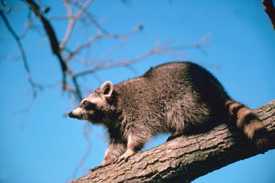Other Wild Animals

Terrestrial carnivores: raccoons, skunks and foxes
Raccoons, skunks, foxes, and coyotes are the terrestrial animals most often infected with rabies in the United States. All bites by such wildlife must be considered a possible exposure to the rabies virus.
Postexposure prophylaxis should be initiated as soon as possible following exposure to such wildlife unless the animal has already been tested and determined not to be rabid. If postexposure prophylaxis has been initiated and subsequent testing shows that the exposing animal was not rabid, postexposure prophylaxis can be discontinued.
Signs of rabies among wildlife cannot be interpreted reliably; therefore, any such animal that exposes a person should be euthanized as soon as possible (without unnecessary damage to the head) and the brain should be submitted for rabies testing. If the results of testing are negative, the saliva can be assumed to contain no virus, and the person exposed does not require postexposure prophylaxis.
Small rodents and other wild animals
Small rodents like squirrels, hamsters, guinea pigs, gerbils, chipmunks, rats, and mice) and lagomorphs including rabbits and hares are almost never found to be infected with rabies and have not been known to transmit rabies to humans.
From 1990 through 1996, in areas of the country where raccoon rabies was enzootic, woodchucks (groundhogs) accounted for 93% of the 371 cases of rabies among rodents reported to CDC.
In all cases involving rodents, the state or local health department should be consulted before a decision is made to initiate postexposure prophylaxis.
The offspring of wild animals crossbred to domestic dogs and cats (wild animal hybrids) are considered wild animals by the National Association of State and Public Health Veterinarians (NASPHV) and the Council of State and Territorial Epidemiologists. Wild animals and wild animal hybrids should not be kept as pets. In instances where wild or hybrid animals are suspected of rabies they should be euthanized and tested for rabies.
Human exposure situations involving animals maintained in United States Department of Agriculture-licensed research facilities or accredited zoological parks should be evaluated on a case-by-case basis.
Rabies in Wild Animals
1958-2008 | 1959-2009 | 1960-2010 | 1960-2011 | 1983-2012 | 1984-2013 | 1983-2014 | 1966-2015
Rabid Raccoons Reported in the United States
2008 | 2009 | 2010 | 2011 | 2012 | 2013 | 2014 | 2015
Rabid Skunks Reported in the United States
2008 | 2009 | 2010 | 2011 | 2012 | 2013 | 2014 | 2015
Rabid Foxes Reported in the United States
2008 | 2009 | 2010 | 2011 | 2012 | 2013 | 2014 | 2015
Related Links
- Page last reviewed: July 5, 2017
- Page last updated: July 5, 2017
- Content source:





 ShareCompartir
ShareCompartir